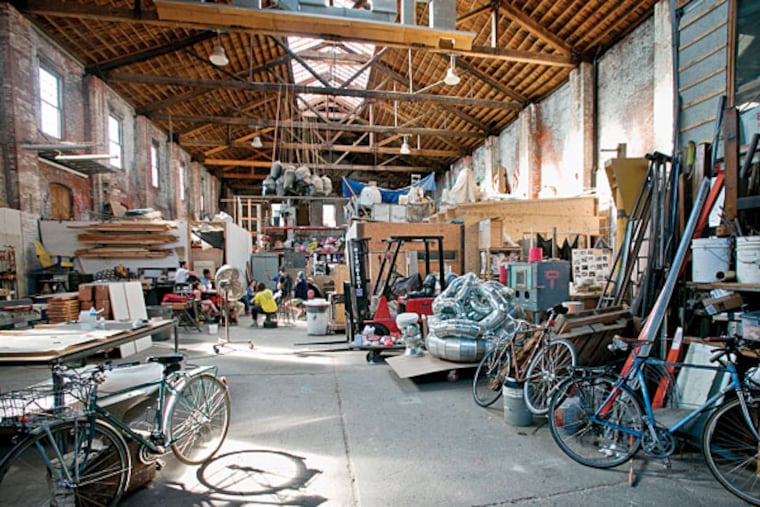Artists' collective inspired by its workspace
When considering the Pennsylvania Academy of the Fine Arts' latest exhibition, it's best to think of its crafty subjects as a big band, not just a bunch of PAFA alumni artists, staff, and faculty congregating to make things out of repurposed wood and metal.

When considering the Pennsylvania Academy of the Fine Arts' latest exhibition, it's best to think of its crafty subjects as a big band, not just a bunch of PAFA alumni artists, staff, and faculty congregating to make things out of repurposed wood and metal.
Better yet, think of them as a big brass band - a 12-person artist collective called Traction Company - whose glorious, clinking, honking noises and epic industrial works (as well as delicate miniatures and half-size models) fill an 8,000-square-foot former trolley-manufacturing warehouse in West Philadelphia. Haverford Avenue at 41st Street has never looked or sounded so industrious (at least not since the trolleys left the building), with table saws buzzing and silver metallurgist hammers banging in work spaces immense and less so.
The PAFA exhibition, also called "Traction Company," reflects that industry with notable single-artist items by members (Connie Ambridge's armor, Steven Lamar Dailey's skullish sculptures); collectively created works such as the Truss project, a full-size replica of the eight huge 19th-century trusses that support the warehouse's 40-foot-high roof; and (relatively) small handmade reproductions of the collective's studio.
"Traction has been my love, my shackle, my blood, sweat, and tears, and I really believe that this PAFA show could help us maintain and grow the small little community we have been for so long into something that gives back and creates opportunities for folk for years to come," says Billy Blaise Dufala, onetime Man Man band member and junk-centric multimedia artist. Other members are John Greig Jr., Miguel Horn, Jeffrey Dentz, Joshua Koffman, Morgan Dummitt, Sedakial Gebremedhin, Laura Giannini, Brendan Keen, and Lucia Thomè.
"There were artists in the space that were also PAFA graduates trying to make something similar happen when John and Billy [and others] decided to found the company in that space," sculptor Miguel Horn says of Traction's 2007 start. "There was never a conscious choice to create an aesthetic per se, but rather the manner in which the members have built out of necessity with salvaged materials in that space has become a characteristic 'look' of the studio."
This resourcefulness and craft - using found materials, "whatever we had at our disposal," says Horn, and giving new stories to the old and left-behind - is what makes Traction members Dumpster divers of the first order, and dreamers after that.
Jodi Throckmorton, PAFA's curator of contemporary art, says the academy's interest in Traction began with modern-art curator Bob Cozzolino's and director Harry Philbrick's being enamored of the collective's work.
"I think Traction proves that work can be beautifully handmade and conceptually rigorous," says Throckmorton. "They reflect an interest in craftsmanship, something that likely goes back to their time at PAFA; an interest in history, in learning traditional techniques, and learning about their place. And they deal with issues of gentrification, something Philly is grappling with, as well as big cities across the country."
The dynamic between each member's personal work and the collectively created projects makes defining a single Traction aesthetic difficult. Not everything in the collective's language is industrialized and chunky.
Dufala notes that each member received classical training at PAFA and says some members' practice is "totally rooted in the classical style, with a lot of figures being sculpted, lots of plaster, rubber molds, bronzes, and waxes. But, yeah, there are also a lot of folks here working with a more contemporary vocab."
That vocabulary is one that Horn says is influenced by the old warehouse and its immediate working-class West Philly neighborhood. "The building offers constant inspiration," Horn says. "It is as raw as can be, and that's a welcome influence for many. But each individual has their own aesthetic, and that is part of the beauty of this collective - having traditional and contemporary practices happen within the same space."
It's the Truss, constructed from salvaged timbers, that embodies Traction's unified vibe, says Dufala.
"I'd say it's very emblematic of the disparate Traction crew that come together to make a strong and supportive studio. Especially as the Truss is a bunch of crazy physics, geometry, and craft that all comes together and forms the roof over our head."
It speaks to the history of the building and the collective's reverence for it, adds Horn. "We tried to replicate the original structures from our building using methods from its original time period. It signifies our concern for the sustainability of our practice, which is so closely tied to the maintenance of the building."
The Truss is a network of segments that, once assembled, creates a structure capable of bearing great loads. "That," says Horn, "is akin to how we at Traction work together to offer a strong network for its members."